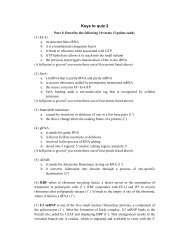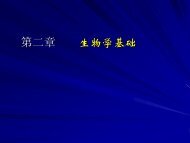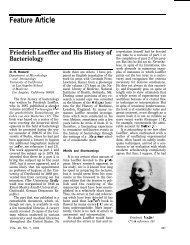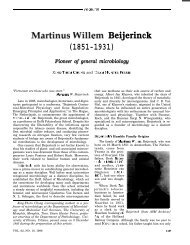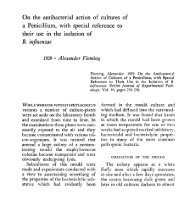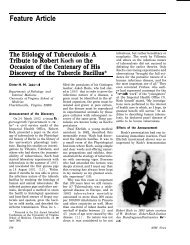splice site
splice site
splice site
Create successful ePaper yourself
Turn your PDF publications into a flip-book with our unique Google optimized e-Paper software.
Generated by Foxit PDF Creator © Foxit Software<br />
http://www.foxitsoftware.com For evaluation only.<br />
Chapter13<br />
RNA splicing
Generated by Foxit PDF Creator © Foxit Software<br />
http://www.foxitsoftware.com For evaluation only.<br />
Outline:<br />
• The chemistry of RNA Splicing<br />
• The Spliceosome Machinery<br />
• Splicing Pathways<br />
• Alternative Splicing<br />
• Exon Shuffling<br />
• RNA Editing<br />
• mRNA Transport
Generated by Foxit PDF Creator © Foxit Software<br />
http://www.foxitsoftware.com For evaluation only.<br />
We have tacitly assumed that the coding<br />
sequence is contiguous:the cordon for one<br />
amino acid is immediately adjacent to the<br />
cordon for the next amino acid in the<br />
polypeptide chain.This is ture in the vast<br />
majority of cases in bacteria and their phage.<br />
But it is not always so for eukaryotic<br />
genes.In those cases,the coding sequence<br />
is periodically by stretches of noncoding<br />
sequence. Most of the eukaryotic genes are<br />
mosaic ( 嵌 合 体 ), consisting of intervening<br />
sequences separating the coding sequence
Generated by Foxit PDF Creator © Foxit Software<br />
http://www.foxitsoftware.com For evaluation only.<br />
Primary transcript<br />
Typical eukaryotic gene
Conceptions:<br />
Generated by Foxit PDF Creator © Foxit Software<br />
http://www.foxitsoftware.com For evaluation only.<br />
Exons ( 外 显 子 ): the coding sequences<br />
Introns ( 内 含 子 ) : the intervening<br />
sequences<br />
RNA splicing: : the process by which<br />
introns are removed from the pre-<br />
mRNA.<br />
Alternative splicing ( 可 变 剪 接 ): some<br />
pre-mRNAs can be <strong>splice</strong>d in more than<br />
one way , generating alternative<br />
mRNAs. 60% of the human genes are<br />
<strong>splice</strong>d in this manner.
Generated by Foxit PDF Creator © Foxit Software<br />
http://www.foxitsoftware.com For evaluation only.<br />
1.THE CHEMISTRY OF<br />
RNA SPLICING
Generated by Foxit PDF Creator © Foxit Software<br />
http://www.foxitsoftware.com For evaluation only.<br />
1.1 Sequences within the RNA<br />
Determine Where Splicing Occurs<br />
The borders between introns and exons are<br />
marked by specific nucleotide sequences<br />
within the pre-mRNAs.These sequences<br />
delineate where splcing will occur.<br />
5’<strong>splice</strong> <strong>site</strong> (5’ 剪 接 位 点 ): the exon-intron<br />
boundary at the 5’ end of the intron<br />
3’ <strong>splice</strong> <strong>site</strong> (3’ 剪 接 位 点 ): the exon-intron<br />
boundary at the 3’ end of the intron<br />
Branch point <strong>site</strong> ( 分 枝 位 点 ): an A close to the<br />
3’ end of the intron, which is followed by a<br />
polypyrimidine tract (Py tract).
Generated by Foxit PDF Creator © Foxit Software<br />
http://www.foxitsoftware.com For evaluation only.<br />
Seequences at the intron-exon boundary
Generated by Foxit PDF Creator © Foxit Software<br />
http://www.foxitsoftware.com For evaluation only.<br />
1.2 The intron is removed in a Form<br />
Called a Lariat as the Flanking<br />
Exons are joined<br />
Two successive transesterification:<br />
Step 1: The OH of the conserved A at the<br />
branch <strong>site</strong> attacks the phosphoryl group of<br />
the conserved G in the 5’ 5 <strong>splice</strong> <strong>site</strong>. As a<br />
result, the 5’ 5 exon is released and the 5’-end 5<br />
of the intron forms a three-way junction<br />
structure.<br />
Step 2: The OH of the 5’ 5 exon attacks the<br />
phosphoryl group at the 3’ 3 <strong>splice</strong> <strong>site</strong>. As a<br />
consequence, the 5’ 5 and 3’ 3 exons are joined<br />
and the intron is liberated in the shape of a<br />
lariat.
Generated by Foxit PDF Creator © Foxit Software<br />
http://www.foxitsoftware.com For evaluation only.<br />
Step 1<br />
Step 2
Generated by Foxit PDF Creator © Foxit Software<br />
http://www.foxitsoftware.com For evaluation only.<br />
The structure of<br />
three-way function
Generated by Foxit PDF Creator © Foxit Software<br />
http://www.foxitsoftware.com For evaluation only.<br />
1.3 Exons from different RNA<br />
molecules can be fused by Trans-<br />
splicing<br />
• The 5’ 5 <strong>splice</strong> <strong>site</strong> of one exon is not always<br />
joint to the 3’ 3 <strong>splice</strong> <strong>site</strong> of the exon.Some<br />
exons can be skipped,and a given exon is<br />
joint to one further downstream.<br />
• Trans-splicing(<br />
splicing( 反 式 剪 接 ): the process in<br />
which two exons carried on different RNA<br />
molecules can be <strong>splice</strong>d together. It occurs<br />
in most all the mRNAs of trypanosomes and<br />
all the mRNA of the nematode worms.
Generated by Foxit PDF Creator © Foxit Software<br />
http://www.foxitsoftware.com For evaluation only.<br />
Transsplicing<br />
Not a lariat but a Y shape branch structure
Generated by Foxit PDF Creator © Foxit Software<br />
http://www.foxitsoftware.com For evaluation only.<br />
2 THE SPLICESOME<br />
MACHINERY
2.1 RNA splicing is carried out<br />
by a large complex called<br />
<strong>splice</strong>osome<br />
Generated by Foxit PDF Creator © Foxit Software<br />
http://www.foxitsoftware.com For evaluation only.<br />
• The transesterifiction reaction described are<br />
mediated by the <strong>splice</strong>osome which comprises<br />
about 150 proteins and 5 RNAs.<br />
• Many functions of the <strong>splice</strong>osome are carried<br />
out by its RNA components.<br />
• The five RNAs(U1, U2, U4, U5, and U6, 100-300<br />
nt)in the <strong>splice</strong>osome are called small nuclear<br />
RNAs (snRNAs).<br />
• The snRNAs is complexed with several<br />
proteins and these RNA-protein complexes are<br />
called small nuclear ribonuclear<br />
proteins(snRNPs).
Generated by Foxit PDF Creator © Foxit Software<br />
http://www.foxitsoftware.com For evaluation only.<br />
• The <strong>splice</strong>osome is the largest<br />
complexes made up of these snRNPs,<br />
but the exact makeup differs at<br />
different stages of the splicing reaction.<br />
• Three roles of snRNPs in splicing:<br />
1. Recognizing the 5’ 5 <strong>splice</strong> <strong>site</strong> and the<br />
branch <strong>site</strong>.<br />
2. Bringing those <strong>site</strong>s together as<br />
required.<br />
3. Catalyzing (or helping to catalyze) the<br />
RNA cleavage and joining reactions.
Generated by Foxit PDF Creator © Foxit Software<br />
http://www.foxitsoftware.com For evaluation only.<br />
A.Interaction of U1<br />
snRNA and the<br />
5’<strong>splice</strong> <strong>site</strong> in the premRNA<br />
then the <strong>splice</strong><br />
<strong>site</strong> is recognized by<br />
the U6 snRNA..<br />
B.The snRNP U2 is<br />
rencognizing the<br />
branch <strong>site</strong>.<br />
C.The RNA:RNA<br />
pairing between the<br />
snRNPs U2 and U6.<br />
D.The same sequence<br />
within the pre-mRNA is<br />
recognized by a<br />
protein at one stage<br />
and displaced by an<br />
snRNP at another
Generated by Foxit PDF Creator © Foxit Software<br />
http://www.foxitsoftware.com For evaluation only.<br />
3 SPLICING PATHWAYS
Generated by Foxit PDF Creator © Foxit Software<br />
http://www.foxitsoftware.com For evaluation only.<br />
3.1 Assembly, , rearrangement, and<br />
catalysis within the <strong>splice</strong>osome:<br />
the splicing pathway
Generated by Foxit PDF Creator © Foxit Software<br />
http://www.foxitsoftware.com For evaluation only.<br />
• Assembly :<br />
1. U1 recognize 5’ 5 <strong>splice</strong> <strong>site</strong>.<br />
2. One subunit of U2AF binds to Py tract and the other to<br />
the 3’ 3 <strong>splice</strong> <strong>site</strong>. The former subunits interacts with<br />
BBP and helps it bind to the branch point.<br />
3. Early (E) complex is formed<br />
4. U2 binds to the branch <strong>site</strong> aided by U2AF and<br />
displacing BBP, and then A complex is formed.<br />
5. The base-pairing between the U2 and the branch <strong>site</strong><br />
is such that the branch <strong>site</strong> A is extruded. This A<br />
residue is available to react with the 5’ 5 <strong>splice</strong> <strong>site</strong>.<br />
6. U4, U5 and U6 form the tri-snRNP Particle.<br />
7. With the entry of the tri-snRNP, the A complex is<br />
converted into the B complex.<br />
8.U1 leaves the complex, and U6 replaces it at the 5’ 5<br />
<strong>splice</strong> <strong>site</strong>.U4 is released from the complex, allowing<br />
U6 to interact with U2 This arrangement called the C<br />
complex.
Generated by Foxit PDF Creator © Foxit Software<br />
http://www.foxitsoftware.com For evaluation only.
Generated by Foxit PDF Creator © Foxit Software<br />
http://www.foxitsoftware.com For evaluation only.
Generated by Foxit PDF Creator © Foxit Software<br />
http://www.foxitsoftware.com For evaluation only.<br />
Catalysis :<br />
1.Formation of the C complex produces the<br />
active <strong>site</strong>, with U2 and U6 RNAs being<br />
brought together<br />
2.Formation of the active <strong>site</strong> juxtaposes the 5’ 5<br />
<strong>splice</strong> <strong>site</strong> of the pre-mRNA and the branch<br />
<strong>site</strong>, allowing the branched A residue to attack<br />
the 5’ 5 <strong>splice</strong> <strong>site</strong> to accomplish the first<br />
transesterfication reaction.<br />
3.U5 snRNP helps to bring the two exons<br />
together, and aids the second<br />
transesterification reaction, in which the 3’-OH<br />
of the 5’ exon attacks the 3’ <strong>splice</strong> <strong>site</strong>.<br />
4.Release of the mRNA product and the snRNPs
Generated by Foxit PDF Creator © Foxit Software<br />
http://www.foxitsoftware.com For evaluation only.<br />
3.2 Self-splicing<br />
introns reveal that<br />
RNA can catalyze RNA splicing<br />
Self-splicing<br />
introns: the intron itself folds<br />
into a specific conformation within the<br />
precursor RNA and catalyzes the chemistry<br />
of its own release.And there t are two<br />
classes of self-splicing introns, group I and<br />
group II self-splicing introns.<br />
Practical definition for self-splicing introns:<br />
the introns that can remove themselves<br />
from pre-RNAs in the test tube in the<br />
absence of any proteins or other RNA<br />
molecules.
TABLE 13-1<br />
Generated by Foxit PDF Creator © Foxit Software<br />
http://www.foxitsoftware.com For evaluation only.<br />
Three class of RNA Splicing<br />
Class<br />
Abundance<br />
Mechanism<br />
Catalytic<br />
Machinery<br />
Nuclear<br />
pre-<br />
mRNA<br />
Very common; used for<br />
most eukaryotic genes<br />
Two<br />
transesterification<br />
reactions; branch<br />
<strong>site</strong> A<br />
Major<br />
<strong>splice</strong>osome<br />
Group II<br />
introns<br />
Rare; some eu-Karyotic<br />
genes from organelles and<br />
prokaryotes<br />
Same as pre-<br />
mRNA<br />
RNA enzyme<br />
encoded by<br />
intron<br />
(ribozyme)<br />
Group I<br />
introns<br />
Rare; nuclear rRNA in<br />
some eukaryotics, organlle<br />
genes, and a few<br />
prokaryotic genes<br />
Two<br />
transesterific-<br />
ation reactions;<br />
exogenous G<br />
Same as<br />
group II<br />
introns
Generated by Foxit PDF Creator © Foxit Software<br />
http://www.foxitsoftware.com For evaluation only.<br />
• Strictly speaking,self-splicing splicing introns are not<br />
enzymes(catalysts),because they mediate<br />
only one round of RNA processing.<br />
• The chemistry of group II intron splicing and<br />
the RNA intermediates produced are the<br />
same as that of the nuclear pre-mRNA.The<br />
introns uses an A residue within the branch<br />
<strong>site</strong> to attack the phosphodiester bond at the<br />
boundary between its 5’end 5<br />
and the end of<br />
the 5’exon5<br />
exon-that is,at the 5’<strong>splice</strong> 5<br />
<strong>site</strong>.Then it<br />
forms a lariat and is followed by a second<br />
reaction in which the newly freed 3’OH 3<br />
of the<br />
exon attacks the 3’<strong>splice</strong> 3<br />
<strong>site</strong>,releasing the<br />
intron as a lariat and fusing the 3’ 3 and 5’ 5<br />
exons.
Generated by Foxit PDF Creator © Foxit Software<br />
http://www.foxitsoftware.com For evaluation only.<br />
3.3Group I introns release a linear<br />
intron rather than a lariat<br />
Instead of using a branch point A, group I<br />
introns use a free G nucleotide or nucleoside.<br />
This G species is bound by the RNA and its<br />
3’OH group is present to the 5’ 5 <strong>splice</strong> <strong>site</strong>.<br />
The two-step transesterification reactions are<br />
the same as that of splicing of the group II<br />
intron and pre-mRNA introns.
Generated by Foxit PDF Creator © Foxit Software<br />
http://www.foxitsoftware.com For evaluation only.<br />
G instead of A<br />
a Lariat<br />
intron<br />
a linear intron
Generated by Foxit PDF Creator © Foxit Software<br />
http://www.foxitsoftware.com For evaluation only.<br />
Group I introns<br />
Group 1 intons are smaller than group II introns and<br />
share a conserved secondary structure, which<br />
includes a binding pocket that will accommodate any<br />
guanine nucleotide or nucleoside as long as it is<br />
ribose form.In addition to the nucleotide –binding<br />
pocket,group1 introns contain an “internal guide<br />
sequence” that base-pairs<br />
with the 5’ 5 <strong>splice</strong> <strong>site</strong><br />
sequence thereby determines the precise <strong>site</strong> at<br />
which nucleophilic attack by the G nucleotide take<br />
place.<br />
The sequence of self-splicing splicing intron is critical for the<br />
splicing reaction ,and sequence requirment holds<br />
because the intron must folds into a precise<br />
structure to perform the reaction chemistry.
Generated by Foxit PDF Creator © Foxit Software<br />
http://www.foxitsoftware.com For evaluation only.<br />
The structure of<br />
the catalytic<br />
region that<br />
performs the first<br />
transesterificatio<br />
n reaction is verh<br />
similar in the<br />
group2 introns<br />
and the premRNA<br />
/snRNP<br />
complex.
Generated by Foxit PDF Creator © Foxit Software<br />
http://www.foxitsoftware.com For evaluation only.<br />
3.4 How does <strong>splice</strong>osome find the<br />
<strong>splice</strong> <strong>site</strong>s reliably<br />
Reasons for the recognition errors:<br />
(1) The average exon is 150 nt, and the average intron is<br />
about 3,000 nt long (some introns are near 800,000 nt).It<br />
is quite challenging for the <strong>splice</strong>osome to identify the<br />
exons within a vast ocean of the intronic sequences.<br />
(2) The <strong>splice</strong> <strong>site</strong> consensus sequence are rather loose.<br />
For example, only AG|G tri-nucleotides is required for<br />
the 3’ <strong>splice</strong> <strong>site</strong>, and this consensus sequence occurs<br />
every 64 nt theoretically.<br />
Two kinds of <strong>splice</strong>-<strong>site</strong> recognition errors:<br />
(1) Splice <strong>site</strong>s can be skipped.<br />
(2) Other <strong>site</strong>s could be mistakenly recognized.
Generated by Foxit PDF Creator © Foxit Software<br />
http://www.foxitsoftware.com For evaluation only.
Generated by Foxit PDF Creator © Foxit Software<br />
http://www.foxitsoftware.com For evaluation only.<br />
Two ways to enhance the accuracy of<br />
the <strong>splice</strong>-<strong>site</strong> selection:<br />
1. Because the C-terminal C<br />
tail of the RNA<br />
polymerase II carries various splicing proteins, co-<br />
transcriptional loading of these proteins to the newly<br />
synthesized RNA ensures all the <strong>splice</strong> <strong>site</strong>s emerging<br />
from RNAP II are readily recognized, thus preventing<br />
exon skipping.<br />
2. There is a mechanism to ensure that the <strong>splice</strong> <strong>site</strong>s<br />
close to exons are recognized preferentially. SR<br />
proteins bind to the ESEs (exonic splicing enhancers)<br />
present in the exons and promote the use of the<br />
nearby <strong>splice</strong> <strong>site</strong>s by recruiting the splicing<br />
machinery to those <strong>site</strong>s
Generated by Foxit PDF Creator © Foxit Software<br />
http://www.foxitsoftware.com For evaluation only.<br />
SR proteins, bound to exonic<br />
splicing enhancers (ESEs),<br />
interact with components of<br />
splicing machinery, recruiting<br />
them to the nearby <strong>splice</strong> <strong>site</strong>s.
Generated by Foxit PDF Creator © Foxit Software<br />
http://www.foxitsoftware.com For evaluation only.<br />
SR proteins are essential for splicing:<br />
1.Ensure the accuracy and efficacy of<br />
constitutive splicing<br />
2.Regulate alternative splicing<br />
3.There are many varieties of SR proteins.<br />
Some are expressed preferentially in certain<br />
cell types and control splicing in cell-type<br />
specific patterns
Generated by Foxit PDF Creator © Foxit Software<br />
http://www.foxitsoftware.com For evaluation only.<br />
4 ALTERNATIVE<br />
SPLICING
Generated by Foxit PDF Creator © Foxit Software<br />
http://www.foxitsoftware.com For evaluation only.<br />
4.1 Single genes can produce multiple<br />
products by alternative splicing<br />
Many genes in higher eukaryotes encode<br />
RNAs that can be <strong>splice</strong>d in alternative<br />
ways to generate two or more different<br />
mRNAs and, thus, different protein<br />
products.The basic answer is that some<br />
<strong>splice</strong> <strong>site</strong>s are used only some of the<br />
time,leading to the production of different<br />
versions of the RNA from different<br />
transcripts of the same gene.
Generated by Foxit PDF Creator © Foxit Software<br />
http://www.foxitsoftware.com For evaluation only.<br />
Alternative splicing in the troponin T gene
Generated by Foxit PDF Creator © Foxit Software<br />
http://www.foxitsoftware.com For evaluation only.<br />
Five different ways to <strong>splice</strong> a pre-<br />
mRNA
Generated by Foxit PDF Creator © Foxit Software<br />
http://www.foxitsoftware.com For evaluation only.<br />
Alternative splicing can be either<br />
constitutive or regulated<br />
Constitutive alternative splicing: more<br />
than one product is always made from a<br />
pre-mRNA<br />
Regulative alternative splicing: different<br />
forms of mRNA are produced at different<br />
time, under different conditions, or in<br />
different cell or tissue types
Generated by Foxit PDF Creator © Foxit Software<br />
http://www.foxitsoftware.com For evaluation only.<br />
Constitutive alternative splicing :<br />
Splicing of the SV40 T antigen RNA
Generated by Foxit PDF Creator © Foxit Software<br />
http://www.foxitsoftware.com For evaluation only.<br />
4.2Alternative splicing is regulated<br />
by activators and repressors<br />
The regulating sequences : exonic (or<br />
intronic) splicing enhancers (ESE<br />
or<br />
ISE) ) or silencers (ESS<br />
and ISS). The<br />
former enhance and the latter repress<br />
splicing.<br />
Proteins that regulate splicing bind to<br />
these specific <strong>site</strong>s for their action
Generated by Foxit PDF Creator © Foxit Software<br />
http://www.foxitsoftware.com For evaluation only.<br />
SR proteins binding to enhancers<br />
act as activators:<br />
(1) One domain is the RNA-recognition<br />
motif (RRM)<br />
(2) The other domain is RS domain rich in<br />
arginine and serine. This domain mediates<br />
interactions between the SR proteins and<br />
proteins within the splicing machinery.
Generated by Foxit PDF Creator © Foxit Software<br />
http://www.foxitsoftware.com For evaluation only.<br />
hnRNPs binds RNA and act as<br />
repressors :<br />
Most silencers are recognized by hnRNP<br />
( heterogeneous nuclear<br />
ribonucleoprotein) family.<br />
These proteins bind RNA, but lack the RS<br />
domains. Therefore, (1) They cannot<br />
recruit the splicing machinery. (2) they<br />
block the use of the specific <strong>splice</strong> <strong>site</strong>s<br />
that they bind.
Generated by Foxit PDF Creator © Foxit Software<br />
http://www.foxitsoftware.com For evaluation only.<br />
Regulated alternative splicing
Generated by Foxit PDF Creator © Foxit Software<br />
http://www.foxitsoftware.com For evaluation only.<br />
Repressors: inhibition of splicing by hnRNPI<br />
Binds at each end of<br />
the exon and conceals<br />
it<br />
Coats the RNA and<br />
makes the exons<br />
invisible to the splicing<br />
machinery
Generated by Foxit PDF Creator © Foxit Software<br />
http://www.foxitsoftware.com For evaluation only.<br />
The outcome of alternative splicing:<br />
1. Producing multiple protein products from a<br />
single gene, called isoforms.<br />
2. Switching on and off the expression of a given<br />
gene.<br />
(1)An exon contains a stop codon,when<br />
incorporated into mRNA,this prematurely<br />
terminates translation generating a truncated<br />
polypeptide.<br />
(2)Alternative splicing used as an on/off switch<br />
is by regulating the use of an intron,which,when<br />
retained in the mRNA ,ensure that species is not<br />
transported out of the nucleus and so is never<br />
translated.
Generated by Foxit PDF Creator © Foxit Software<br />
http://www.foxitsoftware.com For evaluation only.<br />
4.3 A small group of intron are<br />
<strong>splice</strong>d by minor <strong>splice</strong>osome<br />
• Some pre-mRNAs are <strong>splice</strong>d by a low-<br />
abundance form of <strong>splice</strong>osome.This rare<br />
form contains some components common to<br />
the major <strong>splice</strong>osome but other unique<br />
components as well.<br />
• This minor <strong>splice</strong>osome recognizes rarely<br />
occuring introns having consensus<br />
sequences dinstict from the sequence of<br />
most pre-mRNA<br />
• Despite the different <strong>splice</strong> <strong>site</strong> and branch<br />
<strong>site</strong> sequences recognized by the two<br />
systems,these major and minor forms of<br />
<strong>splice</strong>osomes both remove introns using the<br />
same chemical pathway.
Generated by Foxit PDF Creator © Foxit Software<br />
http://www.foxitsoftware.com For evaluation only.<br />
U11 and U12<br />
instead of U1<br />
and U2,<br />
The AT-<br />
AC<br />
<strong>splice</strong>oso<br />
me<br />
catalyzed<br />
splicing
Generated by Foxit PDF Creator © Foxit Software<br />
http://www.foxitsoftware.com For evaluation only.<br />
5 EXON SHUFFLING
Generated by Foxit PDF Creator © Foxit Software<br />
http://www.foxitsoftware.com For evaluation only.<br />
5.1 Exons are shuffled by<br />
recombin-ation to produce gene<br />
encoding new proteins<br />
• All eukaryotes have introns, and yet<br />
these elements are rare in bacteria. Two<br />
likely explanations for these situation :<br />
1. Introns early model – introns existed in<br />
all organisms but have been lost from<br />
bacteria.<br />
2. Intron late model – introns never existed<br />
in bacteria but rather arose later in<br />
evolution.
Generated by Foxit PDF Creator © Foxit Software<br />
http://www.foxitsoftware.com For evaluation only.<br />
Why have the introns been retained<br />
in eukaryotes?<br />
1.The presence of the introns and the<br />
need to remove them, allows for<br />
alternative splicing which can<br />
generate multiple proteins from a<br />
single gene.<br />
2. Having the coding sequence of<br />
genes divided into several exons<br />
allows new genes to be created by<br />
reshuffling exon.
Generated by Foxit PDF Creator © Foxit Software<br />
http://www.foxitsoftware.com For evaluation only.<br />
• Three observations suggest exon shuffling<br />
actually occur:<br />
1. The borders between exons and introns<br />
within a gene often coincide with the<br />
boundaries between domains within the<br />
protein encoded by that gene.<br />
2. Many genes, and proteins they encode,<br />
have apparently arisen during evolution in<br />
part via exon duplication and divergence.<br />
3. Related exons are sometimes found in<br />
unrelated genes.
Generated by Foxit PDF Creator © Foxit Software<br />
http://www.foxitsoftware.com For evaluation only.<br />
Exons encode protein domains<br />
The<br />
dimerzation<br />
domain and<br />
DNA-binding<br />
domain are<br />
cncoded by<br />
separate<br />
exons
Generated by Foxit PDF Creator © Foxit Software<br />
http://www.foxitsoftware.com For evaluation only.<br />
Genes made up of parts of other genes<br />
The same exons are encoded in different proteins
Generated by Foxit PDF Creator © Foxit Software<br />
http://www.foxitsoftware.com For evaluation only.<br />
6 RNA EDITING
Generated by Foxit PDF Creator © Foxit Software<br />
http://www.foxitsoftware.com For evaluation only.<br />
6.1 RNA editing is another way of<br />
changing the sequence of an mRNA<br />
I. Site specific deamination :<br />
(1)A specifically targeted C residue within<br />
mRNA is converted into U by the<br />
deamination.The process occurs only in<br />
certain tissues or cell types and in a<br />
regulated manner.<br />
(2)Adenosine deamination also occurs in cells.<br />
The enzyme ADAR (adenosine deaminase<br />
acting on RNA) convert A into Inosine.<br />
Insone can base-pair with C, and this change<br />
can alter the sequence of the protein. An ion<br />
channel expressed in mammalian brains is<br />
the target of Adenosine deamination.
Generated by Foxit PDF Creator © Foxit Software<br />
http://www.foxitsoftware.com For evaluation only.<br />
The deamination of the base cytosine to<br />
produce uracil
Generated by Foxit PDF Creator © Foxit Software<br />
http://www.foxitsoftware.com For evaluation only.<br />
RNA editing by deamination<br />
Stop code<br />
In liver<br />
In intestines
Generated by Foxit PDF Creator © Foxit Software<br />
http://www.foxitsoftware.com For evaluation only.<br />
II Guide RNA-directed uridine insertion or<br />
deletion.<br />
1. This form of RNA editing is found in the<br />
mitochondria of trypanosomes.<br />
2. Multiple Us are inserted into specific region<br />
of mRNAs after transcription (or US may be<br />
deleted).<br />
3. The addition of Us to the message changes<br />
codons and reading frames, completely altering<br />
the “meaning” of the message.<br />
4. Us are inserted into the message by guide<br />
RNAs (gRNAs) .
Generated by Foxit PDF Creator © Foxit Software<br />
http://www.foxitsoftware.com For evaluation only.<br />
Three regions of gRNAs:<br />
anchor– directing the gRNAs to the<br />
region of mRNAs it will edit.<br />
editing region – determining where the<br />
Us will be inserted<br />
poly-U U stretch
Generated by Foxit PDF Creator © Foxit Software<br />
http://www.foxitsoftware.com For evaluation only.<br />
RNA editing by guide RNA mediated U insertion
Generated by Foxit PDF Creator © Foxit Software<br />
http://www.foxitsoftware.com For evaluation only.<br />
7 mRNA TRANSPORT
Generated by Foxit PDF Creator © Foxit Software<br />
http://www.foxitsoftware.com For evaluation only.<br />
7.1 Once processed, mRNA is packaged<br />
and exported from the nucleus into the<br />
cytoplasm for translation<br />
All the fully processed mRNAs are<br />
transported to the cytoplasm for<br />
translation into proteins
Generated by Foxit PDF Creator © Foxit Software<br />
http://www.foxitsoftware.com For evaluation only.<br />
Movement from the nucleus to the cytoplasm<br />
is an active and carefully regulated process.<br />
The damaged, misprocessed and liberated<br />
introns are retained in the nucleus and<br />
degraded.<br />
(1)A typical mature mRNA carries a collection of<br />
proteins that identifies it as being ready for<br />
transport.<br />
(2)Export takes place through the nuclear pore<br />
complex.<br />
(3)Once in the cytoplasm, some proteins are<br />
discarded and are then imported back to the<br />
nucleus for another cycle of mRNA transport.<br />
Some proteins stay on the mRNA to facilitate<br />
translation.
Generated by Foxit PDF Creator © Foxit Software<br />
http://www.foxitsoftware.com For evaluation only.
Generated by Foxit PDF Creator © Foxit Software<br />
http://www.foxitsoftware.com For evaluation only.<br />
By<br />
闻 博<br />
生 物 科 学 200431060189






